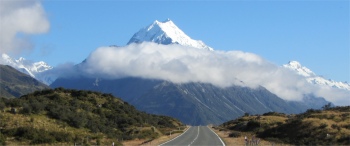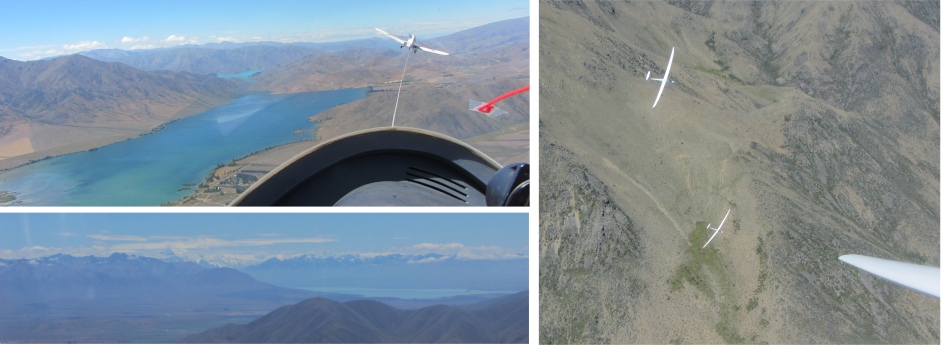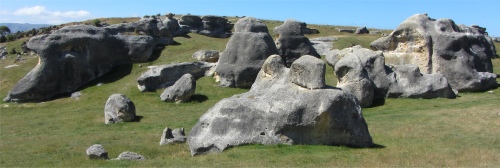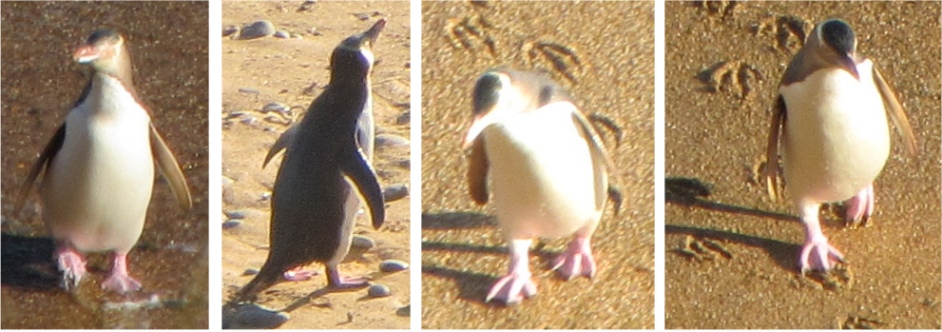I had a chat with Phil and Pip from the adjacent pitch. Their two young sons aged two and four had not stirred yet. They were New Zealanders who had moved to Squamish in Canada. "Did you go across to Canada for your OE?" I asked. "Yes, we did, and I have connections there too. I don't like cities much, so Squamish suited me. It hasn't much of a community spirit though." "And will you eventually return to New Zealand to live; most Kiwis do return at some point," I ventured to add. "I'm not sure. I have a major allergy to grass which goes beyond simple hay fever. There is an awful amount of grass in New Zealand," he joked. The couple were going to take their sons for a bike ride before the rains arrived. I wished them well and drove off.
 Farewell Mount Cook |
The town's most celebrated residents nowadays were the endangered kaki, or black stilts, now one of the rarest wading birds in the world, currently numbering fewer than 100 in the wild. Habitat loss due to the Waitaki hydroelectric scheme, and introduced predators, were the main culprits behind the decline in the bird population.
I dallied in Twizel for a coffee, and since I now had a mobile signal, sent a text to my family to report I was alive and well. I got a reply from my daughter, Sally, telling me she was having a drink with a Kiwi in London. The age of the exchange holiday has returned.
Shortly after leaving Twizel, I passed a sign pointing to the Clay Cliffs. The guide book I had said there were fantastic lunar landscapes to behold at this venue. I ventured 6km down a dusty gravel track to come across a gate which said, "This is private land. To enter and see the Clay Cliffs you must purchase a ticket for $5 from the Omarama Hot Tubs." I had no idea how far away they were, and combined with the distance I had already travelled down the gravel track, no way was I going to scour the planet for a ticket. I travelled a further 4km down the track where I met other souls by the Clay Cliffs who had followed the same tack. Oh, the cliffs, just don't bother if I were you!
I headed further south through expansive tussock and sheep grazing country, and crossed over turquoise canal systems, to Omarama: "place of light". Here, the wind patterns created over the MacKenzie Basin, from air falling down the flanks of the Southern Alps, provided ideal gliding conditions. When in Rome do what the Romans do.
 My Omarama Glider Flight: Top Left - Waitaki Valley, Bottom Left - Mount Cook Range in the Distance, Right - Gliders Below |
12:30 came and I was introduced to Ash, the pilot who was going to do his best to keep us airborne for an hour. He explained there was no guarantee, and the deal was that if we could only stay up for half an hour, I would be charged for half an hour. We shook hands on that, and within minutes I had donned a parachute and was sitting in the front of a two-man glider. Ash was checking with pilots already in the air what the conditions were like at various zones in the valley. It still didn't look too promising, but he made the commitment to fly, and issued a series of instructions to the aircraft that was going to tow us up into the skies. A short briefing followed on what I could touch and not touch inside the glider (I had a duplicate set of controls in front of me), and what I should do in an emergency. These guys didn't waste time, the towing plane took up the slack, we immediately skidded and bumped along the grass airstrip, and then we were airborne.
I was surprised at how much turbulence there was as we climbed. The towing plane in front of me was rising and falling erratically, and so were we. Trying to hold a camera steady in turbulence is not so easy. We climbed and climbed, continually circling a large mountain, and then Ash released the tow rope and the towing craft peeled away to the left, and we were free to soar. It wasn't a silent experience, an air vent was open at the front to stop us baking in the perspex cockpit, and the wind was fairly whistling through the cockpit.
The views were absolutely stunning. Up in the sky I could take in a wide expanse of the Southern Alps instead of the small subset I could see at ground level. In the distance was Lake Pukaki with Mount Cook and his minions proudly standing above the clouds. Further round were peaks that I guessed would be around the Queenstown area. Stretching east was the Waitaki Valley down which the braided Waitaki River flowed via a series of turquoise lakes and dams.
The clarity of the views was stunning. We circled and twisted over the ridges of the large mountain, Ash heroically trying to find rising pockets of air to prolong the magic. I was mesmerised by it all. After a while we were joined by a glider, then another, and yet another, all trying to rise on the same thermals. I was now transfixed looking down on the circling flock below me.
All too soon our time was running out. Ash had managed to keep us airborne by some miracle. I had learned during the flight that Ash was also qualified to fly light aircraft, and also qualified to instruct other pilots under training. "How long is the gliding season here?" I asked. "October until April," he replied. "And what do you do during the winter period?" I enquired. "I just do the same over in British Columbia, Canada," was his succinct reply. "I realise I'll have to get a proper job one day," he laughed.
During the last ten minutes of the flight, he let me have a shot at flying the glider; I was amazed at how responsive it was to the controls. Then he took control back, made a wide bank, brought us in about 4m above a road, and all of a sudden we were skidding down the grass runway. Perfect, absolutely perfect.
I had thoroughly enjoyed the experience and profusely thanked Ash, mentioning it was orders of magnitude than the previous ten minute glider flight that I had at Dunstable many years ago. "We get a lot of guys from Dunstable and Bicester over here to glide," he replied. I'm not surprised.





